
Above: cereal grains; clockwise from upper-left: maize, wheat, rice, millet.
Below: the same grains as puffed "health food" breakfast cereals; clockwise from upper-left: puffed maize, puffed wheat, puffed rice, puffed millet.

Photos by DKJ
Content created: 2005-07-21
File last modified:
Go to
Essay 1,
Essay 3,
Metal Ages,
Mesopotamia.


Photos by DKJ
It is easy to be distracted by the complex and interesting story of the domestication of wheat in the Near East, but it is important to remember that domestication was not limited to wheat, and that it happened outside the Near East as well. In this essay we shall consider some other grains, especially in China, and a broader “nutritional package” of domesticates in the Americas
Millet & Sorghum. We know far less about the origins of agriculture in areas other than the Near East. An interesting Old World area from this perspective is China. Millet and sorghum are both important cereal crops in China, and both are tall, strong grasses that look somewhat like maize (corn), except that the flowers and subsequently the grains are in dense clusters at the top of the stalk.
Archaeological sites in north China dating from about 4000 BC already show evidence of well established domestication of two genera of millet. [Note 1] Both kinds of millet have extremely small kernels, making them a challenge to process, but they are also drought resistant, making them ideal cultigens for the windy, dusty northern China area where they seem to have been cultivated first. [Note 2]
Closely supplementing Chinese millet was a very similar cultivated grain, but an archaeological puzzle: sorghum. In addition to the use of sorghum grain as food, the stalk has traditionally been used for thatching, floor matting, packing and fencing material, and fodder. The roots and occasionally the stalk are a supplementary source of fuel. By historic times sorghum was a major crop in north China and Korea. Indeed, it became so central to the ancient Chinese economy that it was long thought to have originated in the loess (wind-deposited) soils of north China. But there seemed to be no evidence about how or where it could have been domesticated, since the wild and domesticated forms are effectively indistinguishable, and any traces of sorghum in an archaeological site therefore tell us nothing about whether it was wild or domesticated.

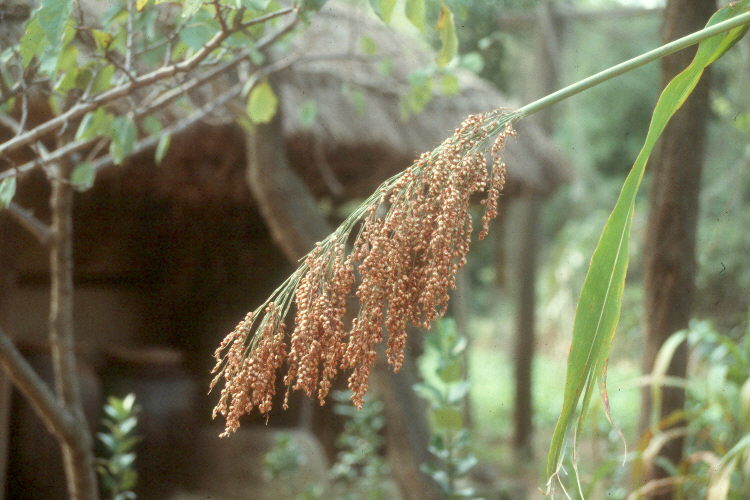
Photos by DKJ
Biology and Domestication. The basic biological properties of these grains had a great influence on their potential for domestication. We have seen that wheat tends to have a high rate of genetic mutation, which provides the basis of new varieties, often well suited to new environments, and accordingly it was comparatively easy to develop strains appropriate to domestication. Maize (corn), as we shall see, tends to inter-fertilize easily with other grasses, producing great variation in the resultant plants, and allowing the variability on which domestication is based. Millet is also manipulable, and China had several varieties by at least 1000 BC. Sorghum, on the other hand, is genetically quite stable, and the plants are self-fertile, so even in modern times it was difficult to produce enough genetic variation to develop “improved” varieties. [Note 3]
Despite its prime importance in north China, sorghum does not appear in Chinese texts until about AD 300, where it is referred to as “millet of Sichuan” (a province in the southwest). This suggests it may have been an imported crop, and that scholars had been deceived by its importance in early historic China into imagining it to have been domesticated there. (See Ho 1975, Appendix 2 [Source].) Latest research suggests that sorghum was grown in Egypt at least as early as in China, if not earlier. [Note 4] The place where domestication must have happened is now considered unknown (rather than China). And there is still no very convincing scenario for the emergence of sorghum from a “wild” ancestor.
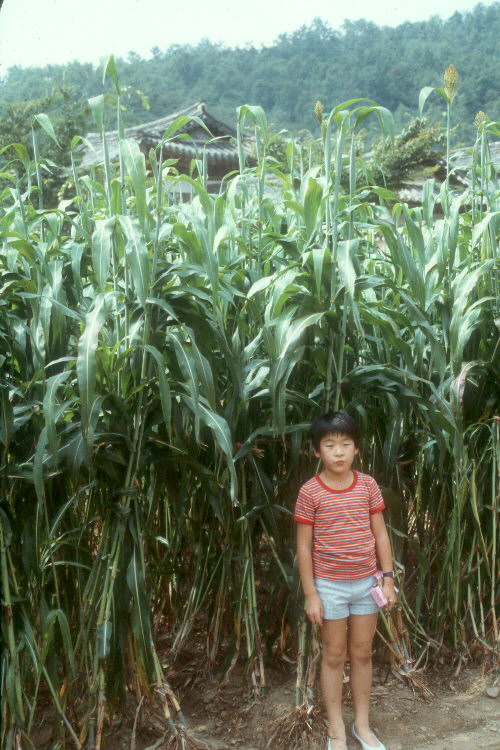

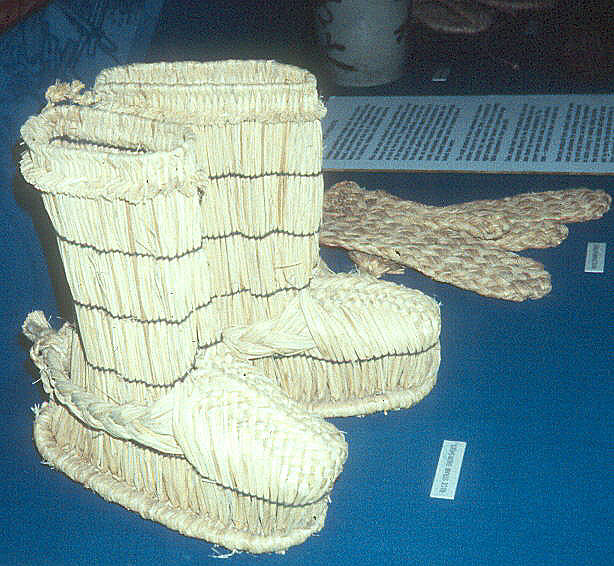
Photos by DKJ
Our comments about early agriculture in China refer primarily to the Yellow River basin, one of the so-called “cradles” of Chinese civilization. A Neolithic village apparently typical of the hundreds that are now known for the region is Bànpō 半坡, outside of the city of Xi’an (Shaanxi Province), where archaeologists found some 200 sturdy timber-and-mud houses of two different designs, which would have a supported a population that we may estimate (depending upon our guess about household size) to be between 500 and 1000 souls.
The population density at Bànpō and its surrounding villages does not provide the only suggestion of Chinese agriculture at this period. Storage pits of millet were also found. In some of the villages in the vicinity, such tools as hoes, spades, and sickles have come to light, similar in form to those of much later times in China. Clearly Bànpō and its neighboring villages, although they are the earliest agricultural communities yet discovered in the Yellow River basin archaeological record, were already well established, entirely agricultural villages.
One historical sociologist (Ho 1975), examining the Bànpō evidence, noted that it is congruent with a system of cultivation possibly implied in much later Chinese texts dating from about 1000 BC. By that time three types of fields seem to have been distinguished, designated by three different terms. Fields newly brought into cultivation (zī 菑) were left dormant for a year:
During the first year the nitrogen in the soil is mostly consumed by the various microorganisms which are the main agent in decomposing plant residues. By the second year, when the plant residues have already been decomposed, the various microorganisms, instead of continually tying up the nitrogen in the soil, release it to nourish the seedplants. This phenomenon of different yields would naturally lead the … farmers to the formulation of the simple rule that fresh-broken lands [should] be rested for a year and millet be grown from the second year onward. (Ho 1975: 50) [Source]
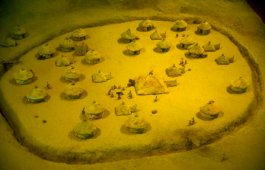
Museum of Modern Art, Taipei
The same term —zī— was used for fields allowed to lie fallow a year between plantings. Two other terms (xīn 新 and yú 畬) distinguished fields ready to be (re)planted and those in active cultivation. Ho extracted this set of agricultural procedures from the early texts and then projected it backward several thousand years to the Bànpō material. That seems daring, but so far no archaeological evidence contradicts such a model. It suggests an extremely well developed system of agriculture, which means of course that we still have not “hit bottom” on the actual origins of Chinese domestication. Just as Jarmo was located in a desolate area of the Fertile Crescent where wheat and barley once grew wild and were therefore available for potential domestication, the same is true for the Yellow River area millet. We may expect earlier Neolithic finds in China as archaeologists continue to work in this area where millet once grew wild. Whether evidence will point to an origin of Chinese agriculture as early as the Near Eastern one, only time will tell.
Rice is today a major cereal crop in India, China, Southeast Asia and, for that matter, much of the rest of the world. Its origins are still unclear, although the distribution of different rice types suggests the possibility of separate domestication in different regions. Rice grows rapidly in warm weather, but is distinctive among major cereal crops in requiring swampy conditions. Traditional rice germinates in heavily saturated mud, and the growing plants thrive only in standing or slowly moving water. Modern Asian rice farmers keep their fields flooded at all times until just before the harvest itself. (Many a rice crop has been lost when wind or rain knocked over the seed-heavy stalks and the grain began to rot in the water below.)
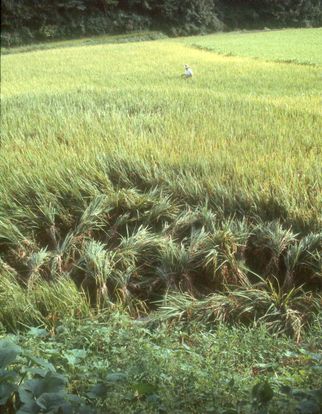
Photo by DKJ
Although today some strains of lower-yielding “dry” rice exist, traditional-style “paddy fields” need constant maintenance to keep the water levels appropriate. Naturally, wet rice production works much better in comparatively flat terrain. To grow rice on a sloping field or hillside the terrain must be terraced into a series of flat fields surrounded by dikes and capable of holding water. This is backbreaking work, and is avoided if flat land is available.
For our understanding of its role in history, the critical fact is that rice has a very high output of calories of nutrition per unit of land devoted to its production. On the other hand, because of the need for constant standing water, it is also an extremely labor-intensive crop. This combination makes it pre-adaptive to conditions of high population density.
Was there rice at Bànpō? Evidence is mixed, and most archaeologists have been cautious about stating that rice was cultivated in China that early. But in 1997 some carbonized rice grains found in northwestern Shaanxi, the province where Bànpō is located, were dated to about 3000 BC. That is later than the settlement at Bànpō, but much earlier than previously realized.
For years, provocative but still very slender evidence also suggested rice cultivation in Thailand early enough to precede or to be contemporary with the development of domesticated plants in China. At the site of Nan Nok Tha, in Thailand, pottery fragments dating from about 3500 BC had impressions of rice chaff in them, suggesting that rice was being grown (or gathered) by people settled enough to be producing such heavy objects as pottery. This was very probably cultivated rice, although the impressions are not clear enough for the biological difference to be visible. Still, some writers began describing Thailand as the possible “homeland” of rice cultivation.
In 2005 there were reports of a few grains of what excavators considered to be cultivated rice dating to an incredibly early 10,000 BC at Jiăhú, the same site in central China mentioned earlier as providing early evidence of Chinese fermented beverages. If the dates and cultivated status are confirmed, this would not only be the earliest date so far for rice, but one of the earliest dates for any cultivated grain anywhere.
In the Americas, agriculture seems to have arisen independently in Mexico and in Peru, and there is increasing evidence of independent domestication in some other regions (including North America). The more researchers look for evidence, the more of it they find:
The remains of pepo squash [pumpkin] dated as early as 5,000 years ago [in central North America] were originally thought to be remnants of species introduced from Mexico, as there were no known wild species in the East that could have served as ancestors. Then in the early 1990s Smith and historian Wes Cowan (of the PBS History Detectives series) discovered the Ozark wild gourd in northwest Arkansas. This was probably the wild ancestor, meaning that pepo squash was another plant domesticated twice: in southern Missouri and in Mexico. (Smith 2008:24) [Source]
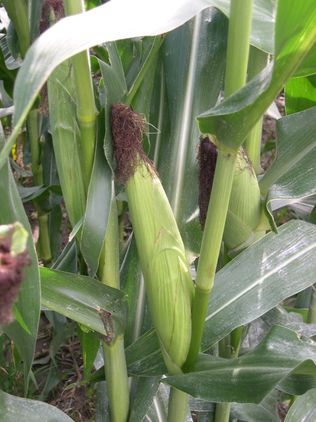
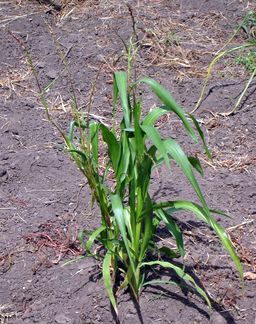
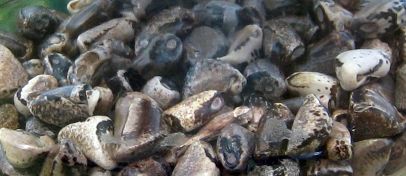
Photos by DKJ
In Mexico research attention has focused especially on the domestication of maize (colloquially called “corn” in American English, although in Britain the word “corn” is applied to all edible cereals). Unlike wheat, the individual grains of maize do not fall to the ground and seed themselves. In all varieties of maize known today, the grains or kernels are clustered together on a cob, covered by a tight husk that prevents the kernels from falling out. Maize as we know it depends on human help for seeding. The presence of maize in an archaeological site is therefore always evidence for the existence of agriculture.
But maize has to have had a wild ancestor, one that would have been able to seed itself and that reasonably could have turned into the familiar article after it was domesticated. There logically has to have existed some kind of “wild maize” that provided the base for the modern domesticate. And in fact fossilized “proto-maize” pollen has been found in the Mexico City area dating to more than 80,000 years ago, well before people arrived in the New World. But it is quite unclear how it actually connects to the maize of later periods.
So far the likeliest candidate for ancestral, probably pre-domesticated maize is a collection of tiny, dried cobs found in a cave in southern Mexico, dating to between 5200 and 3400 BC. As far as can reasonably be reconstructed, there is a great likelihood (but not a certainty) that the husks on these tiny cobs, smaller than a human thumb, opened as the kernels ripened, and the kernels, loosely anchored, fell out. Current thinking is that the modern varieties of maize are the result of a cross between this ancestral strain and wild teosinte [tay-oh-SIN-tay] grass.
In maize, fertilization involves pollen blowing from the “tassel” at the top of the stalk to the “silk” protruding from the end of each cob. If the wind blows the pollens of other grasses onto the maize silk, hybridization easily occurs. This produces both genetic variation and frequent frustration in the New World even today.

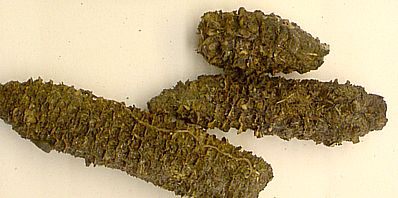
Probably throughout most of its history maize has continually crossed with various wild grasses, producing a range of short-lived aberrant forms. Chance crosses between strains of ancestral maize and nearby teosinte grass, about 1700 years ago, seem to have produced hybrids with larger cobs and apparently with the tight husks so distinctive of maize today. The tight husks would have doomed the hybrids in the wild, as they probably doomed many earlier maize-teosinte crosses, but at this particular time humans were on hand to intervene.
We saw that humans were almost certainly a major factor in the development of non-fractionating strains of wheat, which would have perished in the wild owing to their impaired ability to reseed themselves. Similarly human preference for the more conveniently harvested ears of tightly wrapped maize (each ear larger than older maize and with a full complement of kernels) would have provided a selective factor favoring the continuation of the teosinte hybrid.
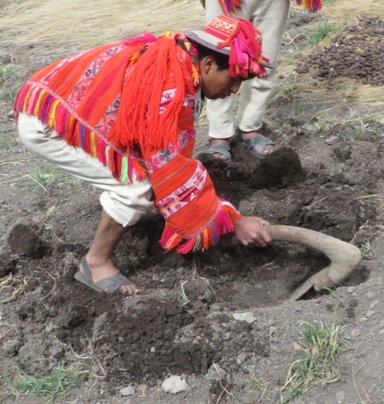
Photo by DKJ
Peru is a country of high mountains and steep valleys. From the steep mountains numerous rivers flow rapidly into the Pacific across a bleak, barren, desert, plain that runs along the coast. Early populations living along this coast subsisted on fish and other sea life rather than by unproductive hunting on the desert. Some kinds of squashes and gourds are native to the valleys of the coastal area, and these were presumably utilized from earliest times. There is no evidence for independent domestication of other crops among the coastal populations, although perhaps in time we shall find evidence of deliberate planting of squashes there.
High in the Peruvian mountains however, agriculture appears to have become important very early. Staples included tomatoes, peanuts, and lima beans, among other things, but the most important domesticate was the potato. Domesticated beans, carbon-dated to about 5600 BC, have been found in the mountains also. [Note 5]
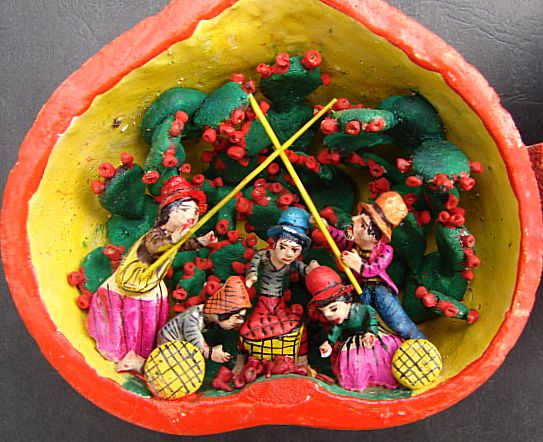
Photo by DKJ
The potato (Solanum tuberosum) grows well in the steep and high mountains of Peru, where grain is both less adaptable and harder to plant and harvest. Potatoes are a good crop for cold climates, since they are extremely nourishing, can be raised in a comparatively short growing season, and, critically, can be stored for a long time in a cool cellar, as is still done throughout the world today. They can even be left unharvested in the soil for a long time (secure from marauding neighbors who will raid a storehouse but not stop to dig up a field).
These advantages made the potato far and away the most important influence on Europe after the European discovery of the Americas, bringing northern Europe greater nourishment with less labor demand than the crops used earlier (McNeill 1999) [Source]. It is said that in our own era the dollar value every year of the world-wide potato crop vastly exceeds the dollar value of all the gold the Europeans ever took from the empires of the New World.
In highland Peru, almost as soon as potatoes were cultivated, the technique arose of freeze-drying potato slices by exposing them to the freezing, dry night air. Freeze-dried potatoes (called chuño) were light, portable, and nourishing, and they rapidly came to serve as a kind of currency. Chuño was collected as tax and used to sustain soldiers and to pay laborers on the extensive road and building projects. [Note 6]
Our discussion so far has focused disproportionately on the domestication of cereals and potatoes. That is justifiable given their historic importance. But food production is not just a matter of calories, and it is not just a matter of domesticating a single crop, however important. Human beings need at least an approximation of adequate nutritional balance, which usually involves a wide range of foods, only some of which were necessarily domesticated. As we study the origins of agriculture, therefore, it is important to take account not merely of one cultigen, but of the whole group of foods that constitute a people’s diet.


Photo by DKJ
Critical from the perspective of nutrition are the vegetables known technically as “pulses,” but typically called beans or peas in English. This huge group includes lentils, kidney beans, navy beans, black-eyed peas, cowpeas, chickpeas, split peas, and hundreds more. (Some other vegetables we call peas or beans in English are not pulses, including green beans, green peas, and soybeans.)
Nutritionally, pulses are mineral-rich, gluten-free, and low-fat, and they have little or no cholesterol (Worldark 2016:7) [Source]. They are about twenty percent protein by weight (roughly double the protein of wheat, triple that of rice. Furthermore, like grains, they can be preserved by drying, making them available year-round.
In the context of settled agriculture, pulses convert atmospheric nitrogen into soil nitrogen compounds that can be used by other plants, thus “restoring” fields formerly used for grain. Some pulses can also free phosphorus in the soil, amplifying this restorative effect. (ibid.) So important are pulses in modern human diet, that the United Nations Food and Agriculture Organization (FAO) declared 2016 the “International Year of Pulses.”
Much of this can be illustrated by further consideration of the early Mexican diet. Not surprisingly, aboriginal Mexican diet did not consist entirely of maize. Like the diet of Mexican peoples of historic times, ancient diet also included squash and beans as important staples, as well as a vast wealth of other domesticated and foraged food, most famously peppers. Archaeologist Richard MacNeish, the discoverer of the tiny cobs of ancestral maize, also unearthed early evidence of domesticated beans and squash.
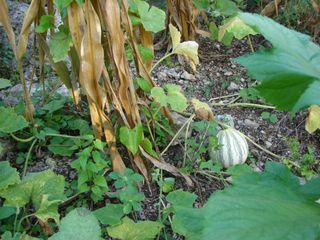
Photo by DKJ
The squash evidence consisted of seeds found in a cave on the Mexican Gulf Coast. Six seeds were found in the same deposits with human remains, three of a smaller, apparently wild variety of proto-squash, and three of a larger variety, which MacNeish considered to have been domesticated. The carbon-14 date puts this find at about 7000 BC. In another find, also on the northern Gulf Coast of Mexico, MacNeish found more of the cultivated squash seeds as well as remains of two species of beans. In 2001 researchers announced further finds of early domesticates along the Mexican Gulf Coast: both squash and maize also dating to between 8000 and 5000 BC.
In squash and beans, as in maize, there is an easily recognized and understood difference between wild and domesticated varieties. Let’s begin with beans.
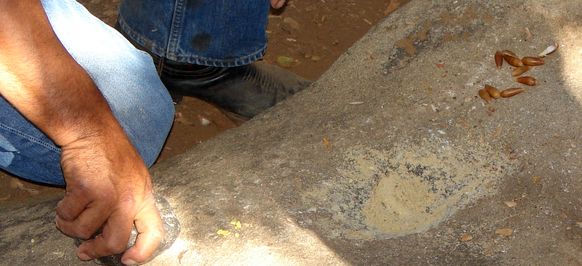
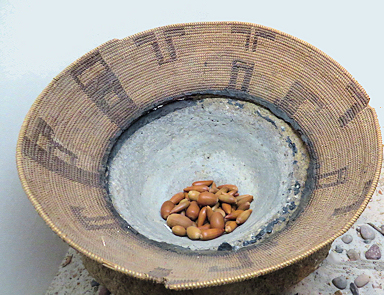
Photos by DKJ
Modern milkweed pods, when they have matured and dried, burst open and hurl their contents in all directions (to the dismay of anyone who puts them in a winter bouquet). So do the seed pods of some common garden flowers, such as impatiens or wisteria. Wild bean pods do exactly the same thing. They burst open and hurl their beans all about. Normal genetic mutation in wild beans, however, produced the occasional pod that malfunctioned and did not throw its beans around normally. Human harvesting (in a situation quite similar to the harvesting of non-fractionating wheat) would have included larger numbers of the non-opening bean pods, and early planting would have introduced a heavy, human selective factor encouraging the growing of the easily harvested non-opening varieties. MacNeish argued that the beans that he found were non-opening ones, dating from between 5000 and 3000 BC.
Squash, beans, and maize form an excellent nutritional complement to each other, and, with vitamin-C-rich peppers, were destined to become the agricultural foundation for settled life in much of the New World.
But what if they were not domesticated at the same time? For a long time researchers were unable to find materials suggesting that squash, beans, and maize were domesticated at about the same time, and the evidence still is not perfect.
Since none of the three by itself provides adequate nutrition to support a settled way of life, and each is subject to theft if left unguarded as harvest time draws near, it was hard to imagine what the long period could have been like in any region where one of these important cultigens had been domesticated without the others. [Note 7] As more evidence accumulates, however, it now appears that these three major items of the diet probably were in fact domesticated at about the same time, but probably not in central Mexico; probably along the marshy Gulf Coast of Mexico. Provocatively, it is along this same coast that we see the rise of the very early Olmec civilization, sometimes called the “mother culture” of later Mexican societies.
Return to top.
Go to
Essay 1,
Essay 3,
Metal Ages,
Mesopotamia.